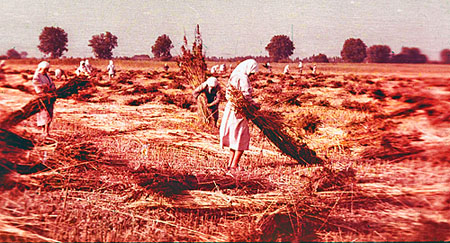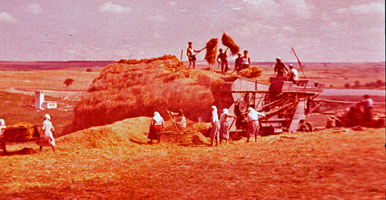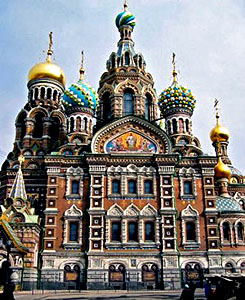In Unit 12 of the course, we will cover in more detail the revolutionary movement that arose in the 1870s in opposition to tsar Alexander II and the "hunt for the tsar," as the revolutionaries called their attempts to assassinate him.
Alexander--who had been well-prepared for the task of ruling Russia; he had traveled throughout the empire and in Europe; he had been involved in the ceremonial functions of being tsar, and he had also worked on government committees and councils--became tsar on 19 February 1855 (crowned 26 August 1856). He succeeded his father in the middle of the Crimean War, which was not going well for Russia. After having defeated Napoleon's huge army just four decades ago and after having Nicholas as tsar with all of his militaristic pretensions, Russia was not able to effectively mobilize its resources to defeat a British (French and Turkish too) invasion of the Crimea. (It was actually easier for the British to supply troops in the Crimea than it was for the Russians!) It was a terrible war for both sides, but it was the Russians who lost. Alexander had to engage in peace negotiations that lead to the Treaty of Paris (30 March 1856) in which the Black Sea was declared neutral, i.e., no Russian warships, and Russia lost some territory at the mouth of the Danube River.
Like Peter the Great well before him, Alexander II realized the need for sweeping reform if Russia was going to remain a great power. There was no way that Russia could modernize its economy and military on the basis of a serf economy. So, in this case, Alexander faced head-first the main thing, that the serfs needed to be free. In 1856 when a group of nobles asked him about his specific intentions vis-a-vis freeing the serfs, Alexander responded:
"I cannot tell you that I totally oppose this; we live in an era in which this must eventually happen. I believe that you are of the same opinion as I; therefore, it will be much better if this takes place from above than from below." (Encyclopedia of Russian History, vol. 1, p. 36)
Alexander's decision to proceed with the emancipation of the Russia serfs prompted Herzen and Ogarev to write in their émigré publication, Kolokol (The Bell) in London: "You have conquered, Oh Galilean!" (That enthusiasm would later wane.)
The "Catch 22"
There were about twenty million serfs (give or take a few million!) and maybe thirty million state peasants. (See my remarks on the Russian peasant commune.) If you just freed all the peasants but gave them no land, then that ensured the ruin of the peasants (and might lead to violence) and a landless rural proletariat. If you freed the peasants and gave them the land that they had farmed, then that meant the ruin of the Russian nobility, who would have no land (and that might lead to violence too). There was no way that the Russian government itself had the money (war debts from the Crimean War were already large enough) to buy the land from the nobles to give to the peasants. So, you can understand how difficult reaching a solution was going to be. Just consider the numbers of people involved!
Once the tsar had decided on the emancipation, there ensued a series of secret committees to work out the details. The process was pushed along by Kolokol and Herzen, who always seemed to know the details of what was going on in the "secret" discussions. The tsar had moments of wanting to relapse and not do the emancipation, but his brother Konstantin and his aunt, the Grand Duchess Elena Pavlovna, pushed him on. Note that there were no peasants on any of the secret committees.
On 3 March (19 February) 1861, the sixth anniversary of his accession, the tsar issued the Emancipation Manifesto--note how short it was. The Manifesto freed the serfs from their personal obligations to the landowners, granted them civil rights and prescribed that the peasants would be able to buy the land from the landlords.
The Emancipation details were complicated. First, there was a transition period of nine years during which time the peasants remained obligated to the landowners, i.e., the serfs were not immediately freed. Second, most of the common land (forests, roads, rivers, marshes, etc) were retained by the land owners. Third, the serfs had to pay the land-owners for their allocation of land (In theory, serfs were to get about half of the land.) in a series of redemption payments. The total sum of all the redemption payments would be advanced by the Russian government to the landowners and then the peasants would pay their amount, with interest, to the government over forty-nine years. Finally, the land given to the peasants was not given to individual peasant households but was granted to the village commune, and it remained the property of the village commune. That meant that each commune (peasant village) was responsible as an entire village to pay the redemption payments to the government. The village commune itself apportioned the land (and accompanying tax due) among its families.
Did anyone prosper as a result of the Emancipation? Certainly not the noble landowners. Most of the redemption payments just went to paying off the landowners' private debts, which were enormous; much of the rest was just spent. In other words, few of the landowners really used the money that they got from the government to invest in their estates or to capitalize their agriculture. More and more nobles sold their estates to pay off their debts, with an estimate that by 1905 the land owned by the nobility decreased by about forty percent. A large portion of what remained was leased out to the peasants. In spite of the terms of the Emancipation settlement, devised to help the Russian nobility, there was little left of a landowning noble class by 1905. The emancipation had not helped the nobility; not sure that it was worth the government's effort to try and save the class.

Russian peasants, what year?
The peasants also did not necessarily thrive after the emancipation. One problem was that estate-owners gave their peasants the poorest land plots and required the peasants to pay first-rate amounts for the land. What was also not good was that peasant population continued to grow, while the amount of land did not necessarily do so. Peasant agriculture, as practiced by the Russian commune, was enormously inefficient also. I have heard figures such as "in 1900 the yield on private land in Russia was about 12 bushels per acre, in Germany 27, and in the UK 35." By the 1890s, Russians were fleeing the countryside for work in the cites where industry was developing rapidly, or they fled Russia for the United States.

Russian peasants, what year?
Finally, take this opportunity to have a look at the article on Alexander II in Wikipedia. (Check out the section entitled, "Marriages and Children.")
Some recommended books
- Jerome Blum, Lord and Peasant in Russian from the Ninth to the Nineteenth Century (1961)
- Ivan Turgenev, Virgin Soil (1877) also Rudin (1856)
- Werner Mosse, Alexander II and the Modernization of Russia (1962)
Some recommended websites
- There were once one or more lectures by the late Professor Michael Boro Petrovich (University of Wisconsin) relevant to this unit available on the web. I am hoping that they will reappear one day. If you are really interested, then you can use this link to search on the Wayback machine for those lectures. You can then figure out how to play the audio.
- Some comments on the emancipation of the serfs by Nikolai Turgenev and by Alexander Nikitenko. Read Count von Moltke account of The Coronation of Tsar Alexander II, 1855.
- Walter Moss has a wonderful online lecture on Alexander II and His Times.
- The Russians sold Alaska to the United States in 1867, In the Beginning Was the Word, The Russian Church and Native Alaskan Cultures.
- Maxime Kovalevsky has some extended comments on The Origin, Growth, and Abolition of Personal Servitude in Russia that are interesting to read.
- Alan Kimball, University of Oregon, "The Village Kabak as an Expression of Russian Civil Society, 1855-1905"
- Alan Kimball, University of Oregon, "Russian Civil Society and Political Crisis, 1859-1863"
